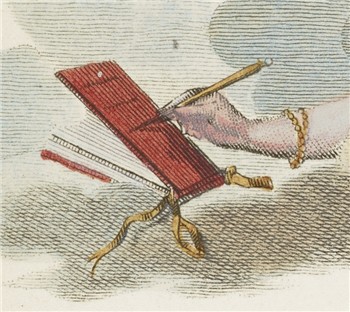When so many men have kept personal records over so many years, why do so many of us persist in thinking of the diary as a women’s form? In today’s guest post, Rebecca Steinitz, author of a forthcoming book on the diary in the nineteenth century, challenges that popular assumption.

Detail from the title page of a nineteenth-century French calendar-diary for women, Petit souvenir des dames(Paris: Louis Janet, 1814). The Morgan Library & Museum; bequest of Julia Wightman, 1994.
Once, at a conference, I gave a talk about the diaries of a famous nineteenth-century meteorologist. Despite his professional status, his male name, and my repeated references to “him” and “his diary,” the first person to ask me a question began, “Ms. Steinitz, you argue that in women’s diaries. . . .” Alas, I wasn’t particularly surprised, for whenever I tell people I’ve written a book about diaries, they invariably respond, “Oh, women’s diaries?”
“Not women’s diaries,” I invariably reply. “Diaries. Men’s and women’s diaries. In fact, one of the things I discuss in the book is why everyone thinks it’s about women’s diaries.”
When we consider names like Samuel Pepys, Ralph Waldo Emerson, and John Cheever, the popular assumption that diaries are for girls is hard to fathom. But if we look more closely at the women’s movement of the 1960s and 70s, it begins to make sense.
From the seventeenth century, when diaries as we know them came into being, through the mid-20th century, lots of men and lots of women wrote lots of diaries, but most well-known diarists were men. Then came feminism. As they made the personal political through consciousness raising groups and protest movements, women latched onto the diary as a particularly conducive form for writing about their lives. At the same time, scholars in the new field of Women’s Studies discovered that women’s diaries could be valuable sources for women’s history and writing. Virginia Woolf and Anaïs Nin became the diary’s foremothers, anthologies of women’s diaries proliferated, and books like A Midwife’s Tale: The Life of Martha Ballard Based on Her Diary, 1785–1812,became bestsellers. Meanwhile, though they still existed, men’s diaries receded from view.
But if most people now think of women when they hear the word diary, they are also harking back to a nineteenth-century tradition, in which, despite the fact that all sorts of people wrote all kinds of diaries, publishers and novelists highlighted the private, emotional women’s diaries that mirrored the private, emotional world women supposedly inhabited. This tradition continues today, in novels, like A.S. Byatt’s Booker Prize-winning Possession, where women’s diaries are the secret centers of the story.
I always enjoy a good fictional diary, but I’ve become firmly convinced that the concept of women’s diaries is itself a fiction, a necessary fiction, perhaps, in that it helped us rediscover many wonderful women’s diaries and inspired many women to write their own diaries, but a fiction nonetheless.
Rebecca Steinitz is a writer and editor. She received her Ph.D. from the University of California, Berkeley, and taught nineteenth-century British literature and women’s studies for many years. Her book Time, Space, and Gender in the Nineteenth-Century British Diarywill be published by Palgrave Macmillan in October 2011.
